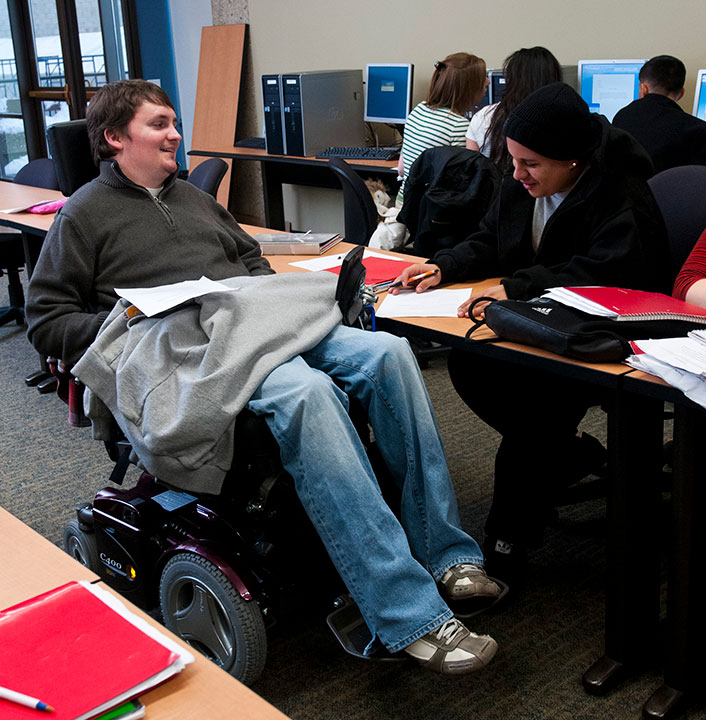At Elgin Community College, the IT organization leveraged assistive technology and information technology to meet the needs of a faculty member with a disability, providing benefits for others across the campus as well.

Findings from the 2019 ECAR Study of Community College and Information Technology suggest that community colleges are doing a very good job of supporting the needs of students with disabilities who require assistive technology to complete their coursework. Since the overall percentage of enrolled students who report having a disability is larger at community colleges than it is at public four-year institutions,1 IT units at community colleges may have more experience with—and success in—serving students, faculty, and staff with disabilities.
Numerous technological adaptations have been utilized by higher education institutions to help individuals with disabilities. While American with Disabilities Act (ADA) regulations require institutions to meet certain accessibility standards,2 these regulations can fall short in addressing the more specific needs of those who require mobility aids like wheelchairs. Whereas opening doors, roaming through campuses, and operating elevators are routine tasks for many people, this is not the case for all individuals with mobility limitations.
In support of the CIO's Commitment on Diversity, Equity and Inclusion and EDUCAUSE's DEI initiative, we in the IT department at Elgin Community College have explored newer and more innovative technology solutions to increase opportunities for individuals with disabilities on campus. Having a quadriplegic colleague helped me realize his dependency on others to open doors and operate elevators. This prompted me to work with my IT staff to come up with a technology solution that would provide this faculty member with greater independence at work. It has also opened the door for us to expand this technology to other buildings on our campus.
The Story of Professor John Mravik
At age 15, John Mravik suffered a life-threatening spinal cord injury in a BMX bicycling accident and was paralyzed from the neck down. After many months of hospitalization and rehabilitation, John was able to breathe on his own again, regain sensation in his body and limbs, and eat. Unfortunately, he was unable to regain full mobility. As a result, John relies heavily on a power wheelchair for mobility and on the assistance of others for many of his day-to-day needs. With the tremendous love and support from his family and friends, John worked through the rough times of recovery and acceptance, and he went on to graduate from high school. When people asked him about his plans for the future, he would answer, "I am going to do what everybody else does after graduating high school. I'm going to college."
John says he was amazed by the help he received from friends and faculty during his college years. His classmates helped him with tasks like turning pages in books, opening doors, and pushing buttons on elevators. After graduating from college, John went on to earn a graduate degree in his chosen field. The support he received as a student inspired him to find a job in higher education. He was hired in 2013 as an English instructor at Elgin Community College, where he became my friend and colleague. I quickly noticed that John depended on others to navigate our campus, so I called on a couple of my IT staff members, and together we came up with an innovative solution to help John be more independent on campus.

Technology Solutions that Empowered John
To reduce John's reliance on others to open doors for him on campus, we adopted the I-PASS/E-ZPASS technology used on tollways. With these systems, highway toll stations are equipped with receivers that read the signals generated by the electronic transponders on vehicles, prompting the toll gates to open. Most of Elgin Community College's building entrance doors have handicap push plates, but John wasn't able to trigger them by himself.
With the electronic transponders in mind, we hired a contractor to install a wireless tie-in that could be retrofitted to the top of the doors' automatic swing mechanism. With this tie-in in place, a triggered proximity transponder (similar to a remote control), was installed on John's power wheelchair. As he approaches the doors, John uses his elbow to activate the transponder, and the doors open for him. We also had an opener with a ratchet accessory installed on John's office door so that he can open and close the door on his own. When he pushes the button on the transponder once, the door opens, and when he pushes it a second time, the door closes. This allows him to have an open door so that students know he is available to meet with them. The nice thing about the transponder system is that it can be expanded to all of the college's doors that are currently equipped with handicapped access. Each remote-control transponder has a unique address and can be programmed to communicate with the openers of specified doors.
To allow John to independently operate the elevator in the building where his office and classrooms are located, we installed a network enabled relay controller in the elevator control room. The controller was programmed to simulate the physical elevator buttons. It also includes a graphical user control interface, which was installed on John's laptop computer (mounted on his wheelchair). John's laptop is equipped with voice-recognition software, which allows him to trigger the relays with voice command. Since most of the new elevators at Elgin Community College are computerized, our elevator vendor graciously brought in—at no additional cost—not only a programmer to write a script for the elevators but also technicians to install the control boards to enable John to operate the elevator with his computer via voice command.
We also engaged a low-voltage contractor to install pipe and box work in the elevator control room, run data cables for the relay controller and all the inner-connect cables, and install the relay controller. The contractor also worked with the elevator company to install, in the elevator shaft, a wireless access point that allows John's laptop to communicate wirelessly with the elevator control board.
With the whole installation complete, John is now able to call the elevator and select his destination floor.
Technology's Impact
Once the project was completed and operational, John told us that it felt unbelievable to be able to ride the elevator and go into his office without any assistance. "I was overwhelmed with a sense of empowerment that doing something so simple completely on my own could help me feel so normal," he said. "I have been a quadriplegic for the last 16 years. Though the thought had not really crossed my mind prior to this experience of true independence, I have basically been asking people for permission to do basic things that everyone takes for granted. Being able to come and go as I please at work has been a thrill for me, and it motivates me when I get up in the morning."
John's story resides at the intersection of diversity, equity, and inclusion (DEI) and applied technology and provided us with some simple but important lessons that we hope others can put into practice on their campuses. First, reach out and listen to people with disabilities on your campus and think about how technology could be leveraged to empower them in their daily work. Second, think creatively about how technologies from one domain might be marshaled to address common problems. Third, collaborate with vendors, as well as staff and faculty across the institution, to devise solutions that can enhance and improve the lives of colleagues, students, and campus visitors. The creation of an environment that is welcoming and accessible to all is our collective responsibility.
Notes
- "Students with Disabilities," Data Points 6, no. 13, American Association of Community Colleges, September 2018; Kimberly Raue and Laurie Lewis, "Students with Disabilities at Degree-Granting Postsecondary Institutions," US Department of Education, National Center for Education Statistics (Washington, DC: US Government Printing Office, 2011). ↩
- "2010 ADA Standards for Accessible Design," U.S. Department of Justice. ↩
Michael Chahino is the Chief Information Officer at Elgin Community College.
© 2019 Michael Chahino. The text of this work is licensed under a Creative Commons BY 4.0 International License.
